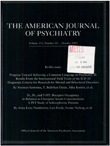Epidemiology of panic disorder in African-Americans
Abstract
OBJECTIVE: The authors investigated the prevalence and clinical characteristics of panic disorder among African-Americans and whites in a community study. METHOD: A total of 4,287 African-American and 12,142 white subjects were interviewed at five sites as part of the Epidemiologic Catchment Area study. Panic disorder and other diagnoses were made using the National Institute of Mental Health Diagnostic Interview Schedule and DSM-III criteria. RESULTS: The lifetime prevalence of panic disorder was 1.2% among African-Americans and 1.4% among whites, a nonsignificant difference. Comparisons between African- Americans and whites on age at onset, years with panic disorder, and suicide attempts revealed no significant differences. Rates of individual panic symptoms in African-American and white subjects with panic disorder were similar, although African-Americans reported a higher mean number of symptoms during their worst episode. Among subjects with comorbid panic disorder, African-Americans and whites had similar rates of major depression, alcohol abuse, drug abuse, obsessive- compulsive disorder, agoraphobia, somatization disorder, and schizophrenia. Patterns of treatment seeking among African-American and white panic subjects were similar, with the exception that African- Americans were significantly less likely to seek help from a mental health professional in private practice. CONCLUSIONS: On the basis of these findings, the authors conclude that panic disorder in the community is similar among African-Americans and whites with respect to lifetime prevalence, age at onset, years of disorder, symptom distribution, suicide attempts, and comorbidity with other psychiatric disorders. Differences in the diagnosis and treatment of panic disorder by race are not due to differences in the prevalence or nature of the disorder.
Access content
To read the fulltext, please use one of the options below to sign in or purchase access.- Personal login
- Institutional Login
- Sign in via OpenAthens
- Register for access
-
Please login/register if you wish to pair your device and check access availability.
Not a subscriber?
PsychiatryOnline subscription options offer access to the DSM-5 library, books, journals, CME, and patient resources. This all-in-one virtual library provides psychiatrists and mental health professionals with key resources for diagnosis, treatment, research, and professional development.
Need more help? PsychiatryOnline Customer Service may be reached by emailing [email protected] or by calling 800-368-5777 (in the U.S.) or 703-907-7322 (outside the U.S.).



